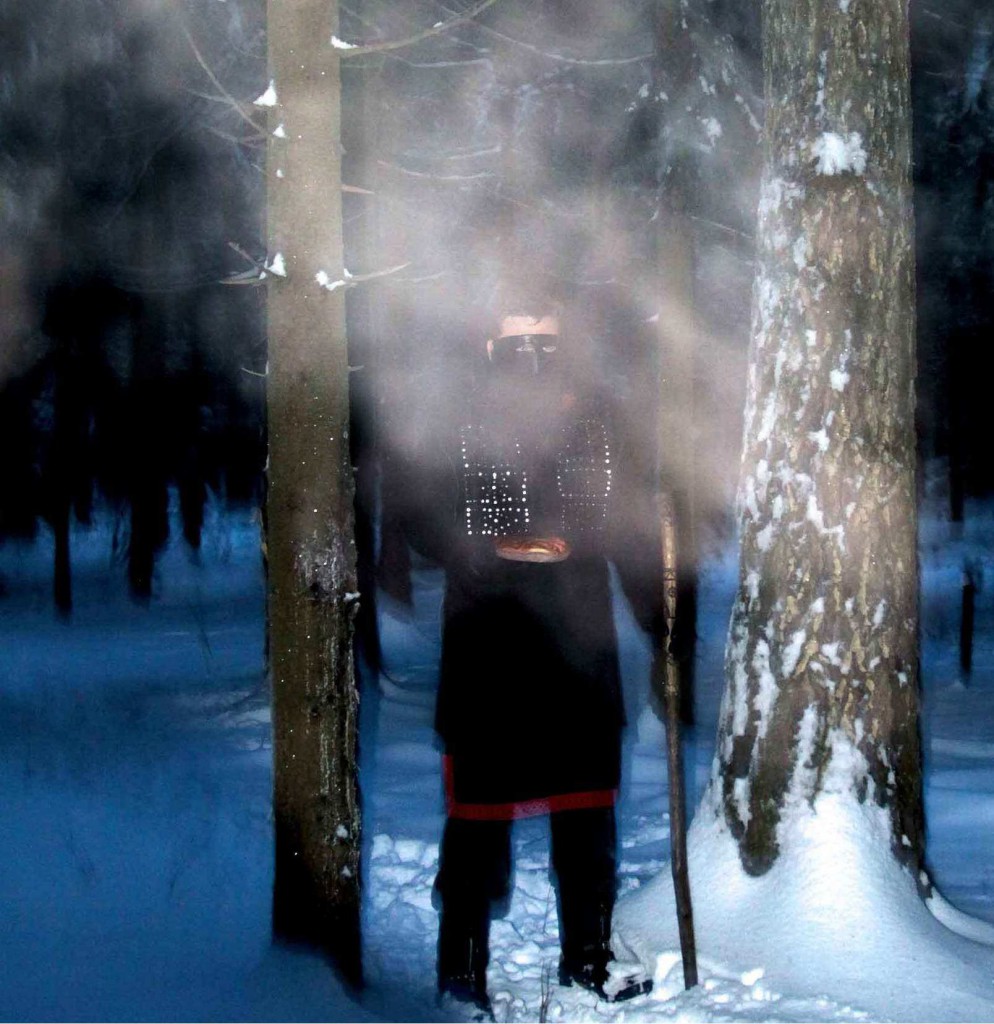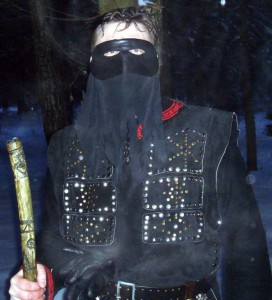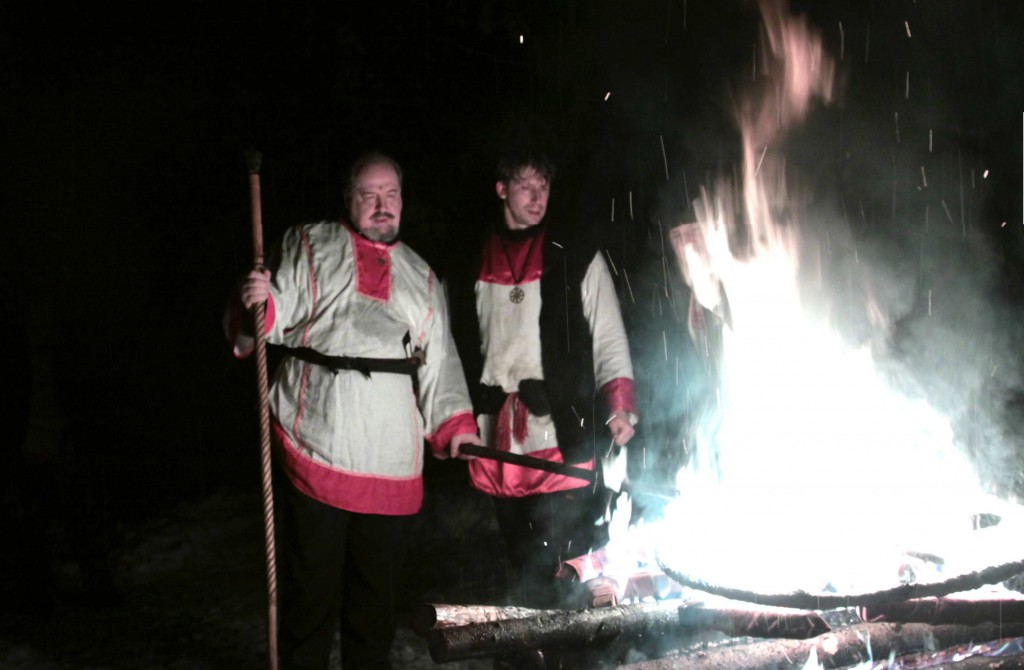It is cold and snowy outside, the days are getting shorter and shorter, and the nights are getting longer. Darkness slowly creeps into the hearts of men. On days like these few people dare to venture outside, dare to brave the dangers of these trying times. Nature itself is eagerly waiting for the final break, yearning for renewal, for the next turn of the wheel. The night reaches its final limits, testing people’s merit again and again, while drowning the brave souls in its darkness, the gloomiest darkness, after which comes the inevitable renewal. The longest night is followed by the promise of the new light, new hope, new joy.
Each European nation celebrated this tricky time of the year after their own fashion. The eastern Slavic nations called this time a festival of Koliada, the Winter Solstice (‘Solntzevorot’ in Russian). Germanic nations celebrated Yule. Even Romans had a similar holiday – the Saturnalia. In Russia this festival is also known as Korochun (or the ‘short day’ in Russian), because it is the shortest day of the year. All of these celebrations had several key elements in common, the most important one being the lighting of bonfires on the longest night of the year to help nature turn from the winter half to the summer, from darkness to light, from gloom to fun and joy.
For centuries, the Church fought fiercely against the Slavic pagan folk
customs and traditions. Yet, despite this struggle, the common folk carefully preserved the key Koliada rites, and faithfully enacted them every year on the longest and toughest night of them all. As of old, the people helped nature cross that ominous boundary between darkness and light. Although, they’ve become Christians, our grandparents still kept the light of the ancient pagan tradition alive in their heart of hearts.
Yggeld, one of the original founders of the Circle of Pagan Traditions, the
largest pagan umbrella organization in Russia, a researcher with the North
Wind Association, a valuable member of the Pagan Federation International, and a famous and respected author of many books on pagan spirituality and the Slavic tradition, have shared the following passage about the folk customs of his family in an exclusive interview:
“I learned about Korochun when I was very little, simply because my own
birthday falls on December 22. My grandmother, Marfa Kuz’minichna
Zaitzeva, was born near Smolensk back in the days of the tsars (she lived to be 99 years old). The common folk in the villages kept the old Slavic
traditions alive for centuries there. She knew many folk songs and wise
sayings, and some of them, as I found out later, were associated with the
folk seasonal rites, including the koliada celebrations.
The verb ‘koliadovat’ (this is a specialized Russian verb, meaning to go
from door to door, singing ritual songs, asking for sweets at Koliada) to me was always associated with the earliest childhood memories – of wearing animal masks, dressing up in funny costumes and collecting sweets from adults into my bag. Koliada for us was the time between Korochun (the Winter Solstice) and the first of January. At this time we usually burned lots of candles and sparklers, to light up this darkest time of the year. Sparks from the sparklers, I think, were supposed to echo the ancient custom of banging the sparks from the burning Budnik (the ritual log, that is lit up at Koliada, much like the English Yule log).
Sviatky(time period in Russia equivalent to yuletide or Christmastide), for
me as a child, were connected to another time period – they were not part
of the Koliada celebration, because my family celebrated Sviatky in January. All the young girls and women in the family would practice the folk divinations at this time, mostly by pouring melted wax into a water bowl.”

Yggeld did a great job pointing out most of the common elements of Koliada
folk customs and rites, which survived in the folk memory of the eastern
Slavic nations to this day. First of all, it is the lighting of fires, candles,
lights, as well as fireworks and sparklers nowadays. Children put on
costumes and masks (in some regions, even the key ritual “koza” or goat
costume can be found) and go from door to door, while holding lamps and
lanterns, singing special koliada songs – koliadki – and collecting sweets.
Generally speaking, these customs still survive in the countryside, far away
from the big cities. It is common knowledge that in Ukraine, and especially
so in Belarus, the folk customs and games at Koliada are much better
preserved than in the Russian Federation.
One of the typical traditional koliada songs (S. Ermakov, D. Gavrilov, 2009):
“It is not just us coming,
We are leading the goat,
Where the goat will go,
The grain stock will grow,
Where she shakes the tail,
There will be an abundance of grain.
Where the goat stomps her hoofs,
There’ll be harvest through the roof
Where the goat shakes her horns,
Will be great huge stacks of corn.”
Veledor, one of the co-chairmen of the Circle of Pagan Traditions, leader of
the Slavic traditional group “Vnuki Dazhd’bozhye” (Grandchildren of
Dazhdbog), head of the folklore group “Gud’ba”, has organized public rituals
and celebrations of Slavic pagan holidays on the grand scale, including
Koliada. In his exclusive interview he shared the following:
“I learned about Koliada at a very early age. Glimpses of this holiday may
be found in many Russian fairy tales, in literature, as well as movies, from
the Soviet period onwards. I consider Koliada to be the most cited Russian
traditional folk festival of our culture. And, perhaps, it is the one, that
endured best – in villages it is still customary to perform koliadovanie every year (masked carolers go from door to door asking for gifts), mysteries with masked processions, the divinations, the perception of this holiday as being the time, when the extramundane world mixes with our own world of mortals most intimately.
In the XXth century many features of this holiday became associated with
the New Year customs and celebrations in the public’s perception. Even now, in our kindergartens kids dress up in costumes, take part in plays, receive gifts and make wishes at New Year’s Eve. Obviously enough, my
grandparents also mentioned to me something about Koliada. Therefore, I
should say, that I’ve known about this holiday for as long as I live. I took
part in the traditional pagan celebration of Koliada for the first time in 2001 with the Slavic group “Koliada Vyatichey” in a log house at the Tsaritsino Park (Moscow). Since then I regularly take part in such rituals. For the last eight years I’ve served as one of the organizers of public rituals, including Koliada.”
In many places, the old traditions are dying out because the older folks
cross the veil into the otherworld, while their children move away to the big cities and don’t pass on the old ways to their progeny. Nevertheless, the fact that the Koliada customs are still around, with their obvious pagan elements, points to the absolute importance of the Winter Solstice to the minds and hearts of our ancestors. Christianity remains the religion of the majority for eastern Slavs, and has been so for a thousand years. All this time the Church took great efforts in trying to eradicate folk pagan beliefs and practices, or, if all else failed, to hijack the rituals and attach them to some Christian holiday or saint day. Many of the old customs and rituals got lost in the ages, but the folk customs at Korochun or Koliada, were kept in the folk conscious memory throughout all these years.
In the mid 1970’s there was a resurgence of interest to folk customs and
pagan symbolism in the folk memory and recorded history among the
educated classes in Soviet Russia. This revival was fueled by published
folklore and historical research by Soviet scientists. This new pagan
movement emerged from the underground and became a new post-Soviet
cultural phenomenon in the early 1990’s.

For the last twenty years or so, the Slavic pagans are openly practicing their rites all over Russia, Ukraine and Belarus. The practitioners of the Slavic traditions are receiving attention from the TV channels, participate on national radio shows, publish books and organize conferences. One
television program in May of 2012, featuring Veledor, the co-chairman of the Circle of Pagan Traditions, mentioned an estimated figure of 15 thousand pagans in Moscow alone!
Koliada is one of the most important festivals for the modern Slavic pagan
tradition. It marks a dark time, a dangerous time, when people hold their
rites to help the Gods turn the wheel of the year from the dark side to the
light, to receive new hope, get the new light. According to S. Ermakov and
D. Gavrilov, authors of ‘Time of Gods, Time of Men’ (Vremya Bogov i
Vremya Liudey), 2009, page 183: “..The entire world is born anew. It
receives hope of the future life. This is the true deep meaning of this
festival. Koliada is the very day of change. It is an act of creation.
Everything that went before this moment, and everything that will occur
afterwards, is its subject and depends on it, and is governed by it…”.
Ermakov and Gavrilov also discuss the nature of Koliada as a point of ‘nontime’, at the very edge of the fabric of the universe, when the veil between the worlds is thin, and the spirits of our ancestors visit the world of the living. The masks and costumes are intended to represent precisely these spirits of our ancestors, who passed over the veil from the world of the living to the world of the dead.
This is how Yggeld describes the Koliada festival celebration in the modern
Slavic pagan tradition:
“For me this is a magical time of the new light being lit within my soul,
the time when I can rid myself of the dark thoughts. The ritual always
contains elements of the mysteries of Fire, held at night. One group of
participants turn into (or swirl into) the ‘Others’, and put on the animal
masks. The ‘Others’ ask the living to give them food and gifts. This very
act, the reception of food and gifts from the living, helps the ‘Others’ enter
the world of mortal matter (Yav’ – the manifested or middle world), which is to say, the ‘Others’ become ‘embodied’. The ‘Others’, then come out of the Darkness and begin to play tricks on mortals, for example, attempt to pull apart the ritual fire stack and thus extinguish the Light.
Also, an Old Man, known as Polaznik, makes his appearance at a Koliada
ritual fire. This is a late version of one of the ancient pagan gods, who helps his people. The Slavs call him Veles, and our children know him as
Grandfather Frost (similar to Santa Claus in GB). Polaznik can also be a
messenger of this God, or his priest. This special guest tests the participants with tricky questions, gives advice and divines the future. Polaznik bangs his staff on a special log in the Koliada bonfire, called the Budnik (it is similar to the English Yule log), until the sparks fly off into the darkness. If these sparks are nice and long, then the fire is known as a merry fire. Such a fire promises abundance and the quick retreat of Darkness.

From this fire the solar emblems are lit, and the participants raise them
high above the ritual site to illumine the night. The ‘Others’ back away from the emerging Light, taking back with them all the dark and gloomy things.”
Veledor also provides a valuable insight into the ritual actions, speaking from his extensive experience in conducting the ritual:
“Koliada is one of the four major Slavic holidays of the solar cycle. On one
hand, this is the longest night – the darkest time of the year, the realm of
the night, and the nature’s definite turn to the winter-long sleep. On the
other hand, it is the beginning of a new cycle, the event, that signals the
growing power of the sun, and the daylight grows from this moment on.
Therefore, this is a time when the otherworldly beings can easily enter the
world of mortals (yav’), it is also the time when one can glimpse the hidden knowledge and change one’s destiny. These elements determine the main points of the ritual actions.
These elements include wearing special masks and costumes, which
represent the beings of Nav’ (otherworld), the costumes help the
participants to channel the images of these beings. This is done, on one
hand, to get in touch with the world of the spirits, the unknown, and at the
same time to substitute oneself for the truly dangerous creatures, to stop
them from manifesting that night. Also, it is the invocation and the arrival of Polaznik (the original prototype of Grandfather Frost), as a manifestation of Veles (the god of the otherworld, of wild nature, hidden knowledge and wealth). He is honored and placated in order to receive, in turn, his blessings. And it is also the sending Budnik (ritually chosen and cut log) forth in sparks, as a messenger through the medium of fire to the Gods with personal wishes. And it is also the various divinations. The number of sparks and the collected gifts tell us about the future harvest and prosperity. The melted wax tells us about the near future. And the young girls are trying to divine, what their intended husband will be like, etc.

The ritual is held with the group of about 20-40 people in the forest. This
year the celebration will be held in Moscow at relatively untouched and wild grounds of the Moscow natural preserve park near the historical burial mounds… Needless to say, that Koliada, similar to most of our rituals, cannot be envisioned without the communal feast, songs, frolicking and folk dances.”
On December 22 pagans all over Russia will be celebrating this ancient
holiday, honouring the Gods, helping them light the flames of new hope,
both in the world outside and within each person’s very soul. Veledor, Yggeld and many other followers of the Slavic pagan tradition will gather in a Moscow park on this day. They will light the koliada ritual bonfire, put on the old masks and sing traditional songs, making sparks fly, so that the ancient mysteries shine again, fill our souls with their eternal wisdom and grant us all strength for this new turn of the wheel of the year!

Let pagans all over Europe, while celebrating their own winter holidays at
this time, think about their Slavic brothers and sisters standing together in
unity with them shoulder to shoulder lit by the flames of ancient bonfires,
brought together by the participation in the sacred mysteries of this Winter
Solstice day!
I would like to thank my co-authors, Yggeld and Veledor, from the bottom of my heart. They wanted to share these personal messages:
Yggeld: “I came to the conclusion that people are the Gods’ helpers in this
mortal Middle World. By celebrating Koliada, we are helping the Gods to
maintain the Great Balance in the universe.”
Veledor: “I would like to congratulate all pagans, everyone who cares for
the traditions of their ancestors, with the coming of this Winter Solstice!”
Author: Gwiddon Harveston, December 18, 2012, Moscow
Co-authors: Yggeld and Veledor







